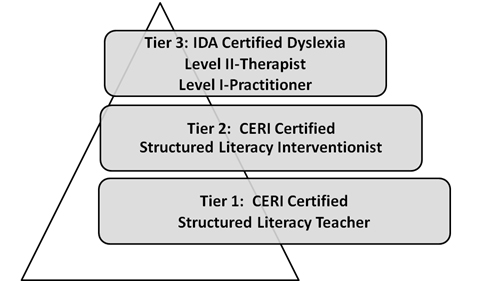Preparing skilled reading teachers

The International Dyslexia Association (IDA) and the Center for Effective Reading Instruction (CERI) have joined forces to create a certification program for teachers of reading. The goal of the program is to encourage the preparation and designation of highly knowledgeable and skilled teachers.
To ensure that reading is taught well to all students, IDA wrote the Knowledge and Practice Standards for Teachers of Reading . Based on current research, the IDA standards outline what a teacher of reading should know and be able to do to teach reading well.
The Knowledge and Practice Examination for Effective Reading Instruction (KPEERI)
Teachers who complete the Reading 101 modules will learn about critical skills for proficient reading and best practices that support students’ acquisition of these skills. As a measure of success in learning the Reading 101 content, teachers may wish to attain certification offered through the Center for Effective Reading Instruction and The International Dyslexia Association. A requisite step to certification is successful completion of the Knowledge and Practice Examination for Effective Reading Instruction (KPEERI) , formerly the Certification Examination for Effective Reading Instruction (CEERI),
The KPEERI was developed under the guidance of Applied Measurement Professionals and with the input of 1,200 educators. The exam is computer-based and consists of 110 multiple-choice questions. There are three types of multiple-choice exam items: recall (34%), application (48%), and analysis (18%).
Exam Type 1: Recall
A recall item requires the examinee to remember specific information. For example:
Parts of speech and sentence structure belong in which language domain?
- Morphology
- Syntax
- Phonology
- Orthography
Exam Type 2: Application
An application item requires the examinee to make use of knowledge. For example:
These errors — hav for have and hors for horse — indicate a student would benefit from instruction in:
- combining forms
- chameleon prefixes
- word origins
- orthographic patterns
Exam Type 3: Analysis
An analysis item requires the examinee to consider and use three points of information to solve a problem or make an instructional decision. For example:
At mid-year, a second-grade student’s fluency rate is 55 words correct per minute. The student’s weekly spelling test average is 65%. The student’s scores on a standardized reading assessment with a mean of 50 and a standard deviation of 21.06 are listed below.
| Subtest | Score |
| Listening Comprehension | 61 |
| Reading Comprehension. | 35 |
| Vocabulary | 39 |
| Word Attack | 34 |
| Word Identification | 37 |
| Spelling | 31 |
While reading aloud, this student misreads the word steep as step. To meet the student’s instructional needs, the teacher should have the student:
- listen carefully as the teacher reads the sentence with the misread word.
- reread the sentence that contains the word repeatedly to improve fluency.
- listen to the teacher dictate the word, say the word, and segment the word into sounds.
- identify the syllable type, determine the vowel sound, and read the word.
For more information about the KPEERI, visit the Center for Effective Reading Instruction website or view the KPEERI Handbook .
Certification
Certification from CERI or IDA aims to encourage the preparation and designation of highly knowledgeable and skilled teachers of reading. The certification program is multi-tiered.
Tier 1 – Certified Structured Literacy Teacher
Classroom teachers are prepared to use data to plan, monitor, and adjust instruction in the general education classroom to meet the literacy needs of students. This certification is awarded by CERI.
Requirements: Successful completion of coursework aligned with the IDA Knowledge and Practice Standards and the Knowledge and Practice Examination for Effective Reading Instruction (KPEERI).
Tier 2 – Certified Structured Literacy Interventionist
Interventionists are prepared to work with those students who in spite of appropriate classroom instruction are not meeting grade-level benchmarks. These individuals also work with and support classroom teachers in planning and implementing literacy instruction in their classrooms that meets the needs of all students. This certification is awarded by CERI.
Requirements: Successful completion of coursework aligned with the IDA Knowledge and Practice Standards, the Knowledge and Practice Examination for Effective Reading Instruction (KPEERI), and a supervised practicum that is commensurate with the certification tier.
Tier 3 – Certified Dyslexia Specialist
Level I: Practitioner
Level II: Therapist
The Certified Dyslexia Practitioner and the Certified Dyslexia Therapist are prepared to work with those students who are diagnosed with dyslexia and related difficulties. These certifications are awarded by IDA.
Requirements: Successful completion of coursework aligned with the IDA Knowledge and Practice Standards, the Knowledge and Practice Examination for Effective Reading Instruction (KPEERI), and an intensive supervised practicum that is commensurate with the certification tier and level.
Visit the IDA website for more information about knowledge and practice standards for teachers of reading .

Figure 1. The three tiers of certification. Tier 1 requires successful completion of the KPEERI. Tier 2 requires successful completion of a supervised practicum and the KPEERI. Tier 3 requires successful completion of additional course work, intensive supervised practicum, and the KPEERI.
The knowledgeable and skilled teacher of reading
Skilled reading is the foundation of academic success, economic opportunities, lifelong learning, and quality of life. The knowledgeable and skilled teacher of reading can make a difference in the lives of his or her students!
Additional resources
In addition to the Reading 101 modules, the following resources will also help you prepare for the Knowledge and Practice Examination for Effective Reading Instruction (KPEERI).
- Expert Perspectives on Interventions for Reading, edited by L.C. Moats, K.E. Dakin, and R.M. Joshi (2012)
- Fundamentals of Literacy Instruction and Assessment, Pre-K-6, edited by M. Hougen and S. Smartt (2012)
- Multisensory Teaching of Basic Language Skills, 3rd edition, edited by J.R. Birsh (2011)
- Multisensory Teaching of Basic Language Skills Activity Book, Revised Edition, by S. Carreker and J. R. Birsh (2011)
The International Dyslexia Association (IDA)
The International Dyslexia Association (IDA) is a 501(c)(3) non-profit, scientific, and educational organization. The mission of IDA is to pursue and provide the most comprehensive range of information and services that address the full scope of dyslexia and related difficulties in learning to reading and write. IDA has been serving professionals in the field and individuals with dyslexia and their families for 55 years.
The Center for Effective Reading Instruction (CERI)
The mission of the Center for Effective Reading Instruction (CERI) is to further evidence-based approaches to reading so that all students acquire the highest levels of literacy and thrive. CERI fulfills its mission by offering certification to general education teachers and reading interventionists that affirms their knowledge and skills in teaching literacy using a structured approach to language. CERI is an independent 501(c)(6) organization founded by the IDA.
